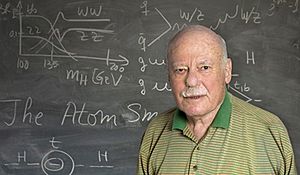Harry J. Lipkin facts for kids
Harry Jeannot Lipkin (also known as Zvi Lipkin) was a brilliant scientist from Israel. He was a theoretical physicist, which means he used math and ideas to understand how the universe works, especially tiny particles and the inside of atoms. He even won a very important award called the Wigner Medal for his amazing work!
Contents
Harry Lipkin's Life Story
Harry Lipkin was born in New York, USA, in 1921. He went to high school in Rochester, New York. He studied electrical technology at Cornell University. There, he also took physics classes from famous scientists like Hans Bethe. He finished college in 1942.
During World War II, Harry worked as an engineer at the Massachusetts Institute of Technology. He helped create a special radar receiver. Later, in 1950, he earned his advanced science degree (a doctorate) from Princeton University. He said his experiments were the first to show how tiny particles called positrons could be understood using a special math idea called the Dirac equation.
Moving to Israel
In 1950, Harry and his wife, Malka, moved to Israel. They wanted to be part of the Kibbutz movement, which is a type of community. But the Israeli government had a different plan for him! They sent him to a French atomic energy center called CEA Saclay. His job was to learn about nuclear energy. This knowledge would help Israel open its first nuclear reactor in Dimona.
In 1954, Harry returned to Israel. He started the country's first course in nuclear physics at the Weizmann Institute of Science in Rehovot. From 1956 to 1958, he advised the United Nations Atomic Energy Commission. Later in his career, he often worked with the Argonne National Laboratory in the United States. Even in 2007, Harry was still working at the Weizmann Institute and at Tel Aviv University.
Harry Lipkin's Discoveries
Harry Lipkin was well-known for using something called "group theory" in physics. This is a way of using math to understand patterns and structures in the universe. He also created models for tiny particles called quarks in the 1960s.
His book, "Lie Groups for Pedestrians," was very popular. Many other physics books and essays were inspired by it. Its name was even similar to a later famous book series called "For Dummies."
Helping Kids Learn to Read
In the 1980s, Harry Lipkin started working with an expert in education named Nira Altalef. They created a method called LITAF. This method helped teach children to read. It was especially useful in Israel, where many children came from families who spoke different languages.
A Funny Science Magazine
In 1957, Harry Lipkin and a scientist named Alexander Kohn started a funny science magazine. It was called Journal of Irreproducible Results. They created it after the first international nuclear physics conference in Israel. This funny magazine later inspired another one called Annals of Improbable Research. From that magazine came the famous Ig Nobel Prize awards, which honor funny or unusual scientific achievements!
Awards and Honors
Harry Lipkin received many awards for his important work:
- The Rothschild Prize in 1973
- The Kaplun Prize in 1980
- A Sackler Scholarship in 1992–1993
- A Weizmann Prize from the City of Tel Aviv in 1994
- The prestigious Wigner Medal in 2002


